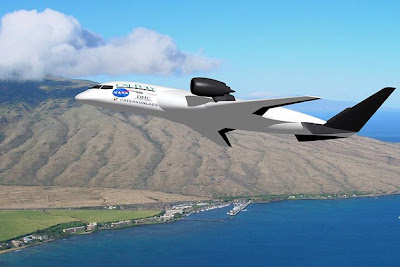Amazing NASA Future Aircraft Designs
 3:13 PM
3:13 PM
 parmeswar
, Posted in
amazing NASA future aircraft design
,
amazing world atlas
,
NASA Advanced Model Extreme Lift Improved Aeroacoustics
,
NASA Boeing Advanced Vehicle
,
NASA Double Bubble D8 Series
,
NASA Flying Wing Aircraft
,
0 Comments
parmeswar
, Posted in
amazing NASA future aircraft design
,
amazing world atlas
,
NASA Advanced Model Extreme Lift Improved Aeroacoustics
,
NASA Boeing Advanced Vehicle
,
NASA Double Bubble D8 Series
,
NASA Flying Wing Aircraft
,
0 Comments
Amazing World Atlas: The Amazing NASA future aircraft designs are eco friendly planes have been named greener flying machines for year 2025.
The computer rendering shows AMELIA which is called as Advanced Model for Extreme Lift and Improved Aeroacoustics a possible future hybrid wing body type subsonic vehicle with short takeoff and landing capabilities. Produced through a three year NASA Research Announcement grant with California Polytechnic State Institute, AMELIA' ability for steeper ascents and descents could reduce community noise levels on takeoff and landing. A model of this configuration is scheduled for testing in a NASA wind tunnel in the fall of 2011.
Boeings advanced vehicle concept centers around familiar blended wing body design like X-48. What makes this design different is placement of its Pratt & Whitney geared turbofan engines on top of planes back end, flanked by two vertical tails to shield people on the ground from engine noise. The design also uses other technologies to reduce noise and drag and long span wings to improve fuel efficiency. This design is among those presented to NASA at end of 2011 by companies that conducted NASA funded studies into aircraft that could enter service in 2025.
The double bubble D8 Series future aircraft design concept comes from research team led by Massachusetts Institute of Technology. Based on modified tube and wing with very wide fuselage to provide extra lift, its low sweep wing reduces drag and weight embedded engines sit aft of wings. The D8 series aircraft would be used for domestic flights and is designed to fly at Mach 0.74 carrying 180 passengers 3,000 nautical miles in a coach cabin roomier than that of a Boeing 737-800. The D8 is among designs presented in April 2010 to NASA Aeronautics Research Mission Directorate for its NASA Research Announcement funded studies into advanced aircraft that could enter service in the 2030-2035 timeframe.
The computer generated image shows possible future flying wing aircraft very efficiently and quietly in flight over populated areas. This kind of design, produced by Northrop Grumman, would most likely carry cargo at first and then also carry passengers. This design is among those presented to NASA at end of 2011 by companies that conducted NASA funded studies into aircraft that could enter service in 2025.
The future aircraft design concept for supersonic flight over land comes from team led by Lockheed Martin Corporation. The team used simulation tools to show it was possible to achieve over-land flight by dramatically lowering the level of sonic booms through the use of an "inverted-V" engine under wing configuration. The revolutionary technologies help achieve range, payload and environmental goals. This concept is one of two designs presented in April 2010 to NASA Aeronautics Research Mission Directorate for its NASA Research Announcement-funded studies into advanced supersonic cruise aircraft that could enter service in the 2030-2035 timeframe.
Our ability to fly at supersonic speeds over land in civil aircraft depends on our ability to reduce level of sonic booms. NASA has been exploring variety of options for quieting boom, starting with design concepts and moving through wind tunnel tests to flight tests of new technologies.
The Icon-II future aircraft design concept for supersonic flight over land comes from the team led by The Boeing Company. A design that achieves fuel burn reduction and airport noise goals, it also achieves large reductions in sonic boom noise levels that will meet the target level required to make supersonic flight over land possible. This concept is one of two designs presented in April 2010 to the NASA Aeronautics Research Mission Directorate for its NASA Research Announcement-funded studies into advanced supersonic cruise aircraft that could enter service in the 2030-2035 timeframe.
Lockheed Martins advanced vehicle concept proposes box wing design which is now feasible thanks to modern lightweight composite nonmetallic materials, landing gear technologies and other advancements. Its Rolls Royce Liberty Works Ultra Fan Engine achieves a bypass ratio nearly five times greater than current engines, pushing the limits of turbofan technology to maximize efficiency. This design is among those presented to NASA at the end of 2011 by companies that conducted NASA-funded studies into aircraft that could enter service in 2025.
Northrop Grummans concept is based on extremely aerodynamic flying wing design. The four Rolls Royce engines are embedded in upper surface of wing to achieve maximum noise shielding. The company used its expertise in building military planes without stabilizing tail to propose this design for commercial aviation market. This design is among those presented to NASA at end of 2011 by companies that conducted NASA funded studies into aircraft that could enter service in 2025.
The Silent Efficient Low Emissions Commercial Transport, or SELECT, future aircraft design comes from the research team led by Northrop Grumman Systems Corporation. Deceptively conventional-looking, concept features advanced lightweight ceramic composite materials and nanotechnology and shape memory alloys. In addition to being energy efficient and environmentally friendly, SELECT improves capacity of future air transportation system which can be used at smaller airports and make them more effective. It is designed to fly at Mach 0.75 carrying 120 passengers 1,600 nautical miles. The SELECT is among designs presented in April 2010 to the NASA Aeronautics Research Mission Directorate for its NASA Research Announcement-funded studies into advanced aircraft that could enter service in the 2030-2035 timeframe.















